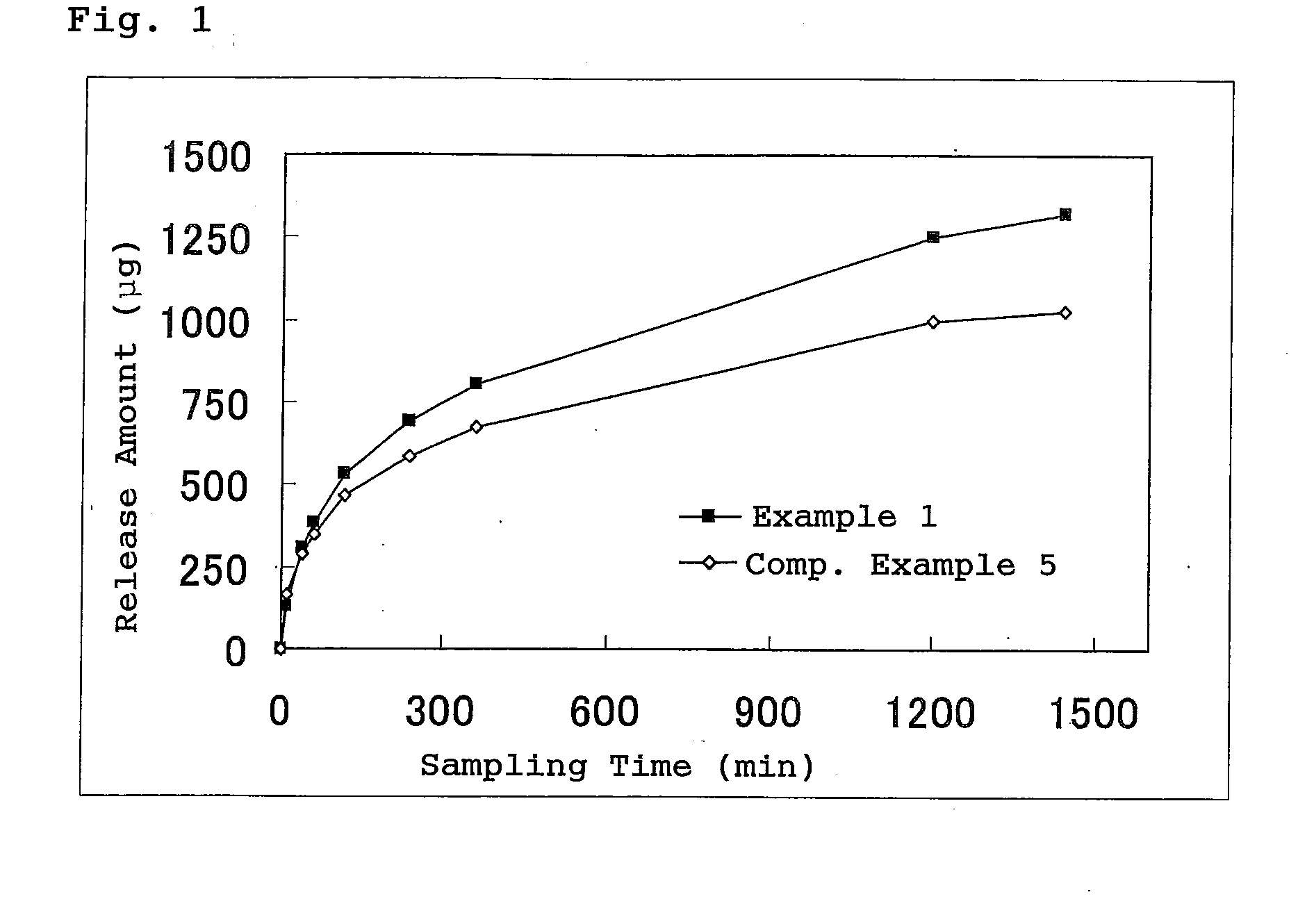Butenafine Hydrochloride-Containing Aqueous Patch
a technology of butenafine and hydrochloride, which is applied in the field of butenafine hydrochloridecontaining aqueous patches, can solve the problems of poor patient compliance with treatment using them, insufficient drug retention on application sites, unfavorable irritation, etc., and achieves the effects of improving the storage stability of the formulation itself, enhancing retention, and improving the retention rate of butenafine hydrochlorid
- Summary
- Abstract
- Description
- Claims
- Application Information
AI Technical Summary
Benefits of technology
Problems solved by technology
Method used
Image
Examples
example 1
[0054]20 g of 20% polyacrylic acid aqueous solution, 1.2 g of tartaric acid, 15 g of concentrated glycerin, 5 g of carmellose sodium, 5 g of partially neutralized polyacrylic acid, 0.07 g of dihydroxy aluminum aminoacetate, 0.015 g of dried aluminum hydroxide gel, and purified water (quantum sufficit) were mixed homogeneously to prepare a hydrogel.
[0055]Subsequently, 1.0 g of butenafine hydrochloride, 0.1 g of methylparaben, and 0.05 g of propylparaben were dissolved in the mixed solution of 2.5 g of glycol salicylate and 15 g of propylene glycol, and then the resulting solution was dispersed homogeneously into the previously prepared hydrogel to produce a gel paste for the patch.
[0056]A patch was produced by spreading the gel paste onto a stretchy nonwoven fabric and covering the surface of the paste with a polyester film.
experimental example 1
Adhesion Durability Test
[0064]The formulations produced in Examples 1 to 5 and Comparative Examples 1 to 5 as described above were individually applied on finger nails, and the adhesion state and the state of undesirable stickiness after 8 hours were evaluated based on the following criteria.
[0065]◯: highly adhesive
[0066]Δ: poorly adhesive (partially peeled off)
[0067]X: no adhesiveness (easily peeled off)
[0068]◯: not sticky
[0069]Δ: slightly sticky
[0070]X: clearly sticky
[0071]These results are shown in Table 4. As is understood from the result shown in the table, the aqueous patches of Examples 1 to 5 had excellent adhesiveness and a little undesirable stickiness.
TABLE 4ExamplesComparative Examples1234512345Adhesiveness◯◯◯ΔΔ◯◯◯ΔXUndesirable◯◯◯◯◯◯ΔΔΔXstickiness
experimental example 2
Drug Dispersibility
[0072]The drug dispersibility in the gel paste of aqueous patches produced in Examples 1 to 5 and Comparative Examples 1 to 3 as described above was observed visually or under a polarization microscope.
[0073]The result is shown in Table 5 below.
TABLE 5ComparativeExamplesExamples12345123DispersibilityGoodGoodGoodGoodGoodGoodPoorPoor
[0074]In the patches of Comparative Examples 2 and 3, deposition of crystals due to drug aggregation was visually observed. The drug dispersibility in these patches was very poor, and the drug was not successfully dispersed homogeneously in the gel paste.
[0075]In contrast, in the aqueous patches of Examples 1 to 5 which include glycol salicylate and propylene glycol according to the present invention, no drug aggregation was observed and the drug was dispersed well in the gel paste.
PUM
| Property | Measurement | Unit |
|---|---|---|
| thickness | aaaaa | aaaaa |
| thickness | aaaaa | aaaaa |
| diameter | aaaaa | aaaaa |
Abstract
Description
Claims
Application Information
 Login to View More
Login to View More - R&D
- Intellectual Property
- Life Sciences
- Materials
- Tech Scout
- Unparalleled Data Quality
- Higher Quality Content
- 60% Fewer Hallucinations
Browse by: Latest US Patents, China's latest patents, Technical Efficacy Thesaurus, Application Domain, Technology Topic, Popular Technical Reports.
© 2025 PatSnap. All rights reserved.Legal|Privacy policy|Modern Slavery Act Transparency Statement|Sitemap|About US| Contact US: help@patsnap.com

